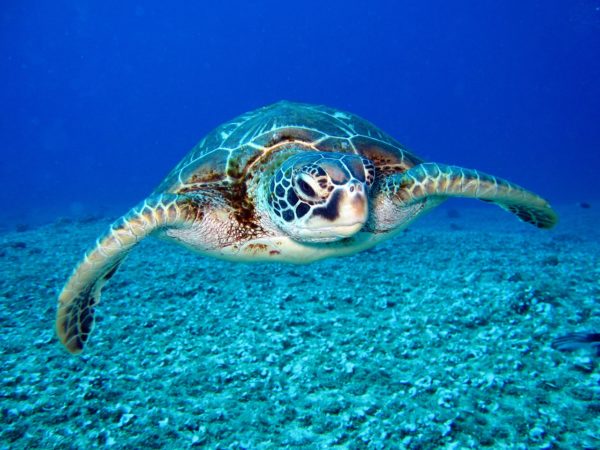Turtles are known to live in both water and on land. These reptiles can live for more than thirty years, and there are three hundred and thirty-four turtle species. But, the question is: can turtles live without water?
In this article, we’ll attempt to answer that question by discussing some of the factors that determine the lifespan of these fascinating creatures.
Table of Contents
The Short Answer
No, turtles can’t survive without water. They’re similar to any living creature, and as such, they need water to survive. Without water, they’ll dehydrate and, in the end, die.
But, the lifespan of these cold-blooded animals on land depends on several factors. In relation to their habitat, land turtles can live longer than sea and semi-aquatic turtles.
Age is another determinant of how long a turtle can live without water. Adult turtles who’ve lived more than five years are more likely to stay longer without water than day-old and young turtles.
Also, the climate of the environment can affect the lifespan of turtles. For example, turtles can’t survive for long in areas with very high temperatures and low humidity. Finally, brumation or hibernation can also affect the survival of turtles without water.
Factors That Determine the Lifespan of Turtles Without Water
Several factors influence how long a turtle can live without water, as we just discussed briefly. Here’s a list of some of them in more detail.
1. Type of Species
There are over three hundred species of turtles, which can be grouped by their habitat. There are sea, land, and terrapin turtles.
Sea Turtles

Sea turtles spend most of their life in water. The Loggerhead turtle, Leatherback turtle, Archelon, and the Green sea turtle are examples of sea turtles.
The males could live their whole lives in water without setting foot on land, mainly coming to the shores just to brumate. In contrast, the female sea turtle periodically comes to the seashore to lay their eggs.
These aquatic turtles can only survive for just a few days out of water.
Land Turtles

This group of turtles lives most of their lives on land. Examples of land turtles are the Eastern box turtle, the Gulf Coast box turtle, the Florida box turtle, and the three-toed turtle. They can actually swim, but you’ll barely see them in water.
Often referred to as tortoises, these land turtles mainly need water to cool off at very high temperatures. They’ve adapted to living on land, so they can stay for months right where they are.
Terrapins or Semi-Aquatic Turtles
Terrapins or semi-aquatic turtles are those that can live both on land and in water for years. Examples of terrapins include the Red-eared slider, the Wood turtle, the Diamondback terrapin, and the Pond Slider.
From skins that can’t be permeated by salt to webbed solid hind feet, this group has several characteristics that help them adapt in both environments.
2. Age
The next factor that determines how long a turtle can survive without water is age. Hatchlings and turtles below the age of five can’t survive for long out of water. Similar to their age, young sea turtles don’t have strong, adaptive bodies to help them survive longer on land.
On the other hand, adult turtles, old enough to mate and reproduce, can spend weeks on land. When out of the water, their bodies have to produce more energy to help them adapt to the environment.
3. The Climate of the Environment
Turtles are affected by two main climate conditions: temperature and humidity. Turtles are cold-blooded animals, and as such, they can’t regulate their body temperature. Instead, they depend on the environment’s temperature.
When the weather is too hot, they need water to cool off. For this reason, some turtles can’t stay on land for long at very high temperatures. During hot seasons, land turtles are often seen in and out of water.
Also, turtles can stay longer out of water in very high humid areas. Most trees and other shady areas have high humidity and low temperature, making them accommodating for turtles. The reason is that it prevents them from burning more energy, which translates to them surviving for a longer period without water.
4. Hibernation or Brumation
In seasons when we have low temperatures and longer nights, reptiles, including turtles, brumate. Similar to hibernation in humans, turtles sleep for months when brumating. It’s as if they’re dead, but they’re just lying dormant.
During this period, their metabolism rate is reduced to the barest minimum. As a result, turtles don’t eat or drink anything, keeping their energy levels very low. So, brumation is a period for energy conservation in turtles.
Turtles can brumate in either water or on land. Those that brumate on land can stay over three months without water, which is a very long period.
While age is no barrier to brumation, and even young turtles can brumate, not all turtles brumate. Turtles bred away from the wild, usually pet turtles, rarely brumate.
Why Do Turtles Need Water to Survive?
Water is life. This statement isn’t only true for humans but all other creatures, including turtles.
Turtles need water for a number of reasons. To begin with, they need water to cool off, especially during summer when temperatures are high. The temperature of the water helps to regulate the warm bodies of these turtles.
Surprisingly, water also helps turtles to eat. These creatures don’t produce saliva, so water helps moisten their food, making it easier to swallow.
Finally, turtles drink water to help speed up their metabolism rate, which helps them produce a lot of energy.
What Type of Water Is Good for Turtles?
If you have a turtle as a pet, we’re sure that one of the many questions you asked yourself is: what type of water is good for your pet?
Is tap water good for them? No. Tap water contains chlorine and fluoride, and this isn’t good for the health of your turtle. If you want to use it, you’d have to treat it by dechlorinating and filtering it.
Some people argue that seawater is good for turtles. This statement isn’t entirely true. Seawater contains salt, which isn’t suitable for turtles. It’s irritating even though it kills bacteria in the water. Yet, the good news is that turtles can naturally filter out salt.
They have filter glands behind their eyes that take out the salt from the water. This mechanism essentially prevents them from drinking salty water, but it doesn’t take care of the irritation.
Can Turtles Drown?
Yes, they can. Like any other reptiles, turtles do have lungs. This means they need oxygen to help them stay underwater. They can only last underwater for minutes without oxygen. Mostly, they come out to the surface of the water to breathe.
But, sometimes, it depends on the type of turtle. Sea turtles are more likely to stay longer in water than those on land. Also, land turtles can’t swim in deep waters, and they can easily drown.
As a side note, while we’re at it, don’t turn your turtle upside down or shake it as first aid if it drowns. Doing this will only take away any chances of reviving it.
You can start by gently grabbing its head and pulling it downwards. Ensure the turtle’s mouth is open to help drain out water, too. After, lay it flat on its stomach and simultaneously pull out its front and hind legs. This will help drain out any remaining water. Also, take them to the vet in all cases.
Factors That Can Force Your Turtle Out of Its Aquarium

You can sometimes find your pet turtle out of its aquarium. Many factors can account for this situation.
The shortage of oxygen can be one of the main factors. Like other sea creatures, turtles intermittently come out of the water to breathe in air. They do this to prevent them from drowning or suffocating due to lack of oxygen. As a result, if they notice less oxygen in the aquarium, they will be forced to come out.
Several factors contribute to low oxygen levels in your aquarium, including overcrowding, water contamination from waste, stagnant water, and the absence of light. To prevent your turtle from coming out or suffocating, always ensure that the water in the aquarium is clean.
You can also ensure that the aquarium is big enough to house more turtles. If not, keep only a few turtles in each aquarium.

Food shortage can also force your turtle out. Everyone needs food to survive, and the situation is no different for turtles. If they don’t have enough food, they’ll begin to starve. In their quest to survive, they’ll force themselves out of the water. Avoid such a situation by ensuring that there’s always enough food in the aquarium.
Finally, the water temperature of your aquarium can also cause your turtle to leave its habitat. As already stated, turtles are cold-blooded animals. This means that they can’t regulate their body temperature.
If the water in the aquarium is too cold, the metabolism rate of these turtles begins to slow down. As a result, their bodies are unable to produce more energy causing them to need more oxygen.
Similar to cold water, it’s not also advisable for the water to be too hot. So make it a point to regulate the temperature of the water in your aquarium. Remember, it’s the main factor that determines the temperature of your turtle.
If a turtle is forced to come out of its natural habitat, you endanger its life by exposing it to prey. This can lead to its untimely death.
Final Take
Turtles can live for days, weeks, or even months without water. In a brumation period, when their bodies hibernate, they can stay for months without needing water. But, when they’re not brumating, they can only last a few days or even minutes without water.
Apart from brumation, the age of a turtle can also affect its lifespan without water. Adults turtles survive longer than young ones. Also, turtles survive longer without water in low temperature and high humid areas.
Ideally, it’s not good to stay without water for long. These turtles are like any other creatures, and being dehydrated can affect their health or, even worse, shorten their lifespan. If you have one as a pet, ensure that it’s always hydrated.
Lastly, make it a point to always keep your turtle’s tanks filled with fresh and clean water and prevent it from coming out of the aquarium by constantly supplying it with food and oxygen.
